The Principles and Process of Gem Sprays for Medicinal Plants
By Dennis Klocek 37 min read
Recent research on the relationship between climate change and plant growth has revealed an unusual paradox. It seems that the more CO2 a plant has available in the atmosphere the larger it grows. However this growth is accompanied by a ubiquitous 8% reduction in potassium, calcium, iron, zinc, and plant protein in the cells of all plants that have been analyzed. This has raised an alarm among nutritionists and the medical profession.
Botanically this is a manifestation of a classic polarity of growth and form in plants. Growth is at the expense of form and form is at the expense of growth. Form and growth are the two poles that oscillate in the life of plants. Generally, more fertilizer produces growth. Less fertile conditions create finer forms. The form side of this polarity contributes to much more potent medicinal properties in plants. Stronger form forces yield potent medicinal properties. Metals like potassium and iron in plant sap regulate nutrient transmission throughout the growth cycle into flowering. These are strongest when the form is more articulated.
The form side of the form/growth polarity contributes to much more potent medicinal properties in plants.
The goal of this paper is to put forward a method for providing an extremely fine spray of gem materials that, as minerals, have already reduced potassium, calcium, iron, and zinc into highly dilute and highly potent forms that enhance the chemistry of medicinal plants.
It could be said that a gem actually mimics the flower production of a medicinal plant. The key is to render the gems into such a fine form that a light application of finely ground gem material covers the surface of the leaf engendering what is known as gaseous electrolytic activity. The following paper describes this process.
The researcher Rupert Sheldrake has coined the term morphogenetic field for the concept that the organism is receiving cues from a field of forces that inform the potentials for organ formation. This older concept is supported today by the field of epigenetics that is based on the idea that the genetic material in an organism is predisposed to prior conditions that the genes receive that allow them to organize into particular forms used by organisms to manifest the correct genetic protocols in the process of manifesting into form. These ideas go even further back into the research of D’Arcy Thompson, a renowned morphologist who, in his classic book On Growth and Form states that germ material is always the seat of forces and never the source forces.

Thompson’s ideas go back to the morphological studies of the German poet J.W.V. Goethe whose research into plant and animal morphology prompted him to coin the word morphology, literally the language or speaking of the body. Goethe in turn inherited his impulses from the alchemists like the great Paracelsus who understood that all formative forces come to organisms through processes of precipitation and rarification known as sal and sulf. In this worldview these forces existed as a realm of energetic templates known as the entelechy. Entelechy comes from the ancient Greeks who understood that the spiritual realm is populated by archetypal presences that guide the manifest world with similar forces whether they be in the mineral, plant, animal or human realm. This is the imaginal realm, the realm of magic and miracle. The transformational laboratory of healers.
In the early 1970s, I was being introduced to these ideas and began a series of experiments to see if morphological traits could be transferred with reliability between plants. The goal was to produce plant ferments that would transfer plant organ gestures to a cultivated plant. The working thesis was that wild plants in large families could give a purer familial gesture to cultivated plants in the same family. The research chosen was with the mustard family with the cultivated plant being cabbage and the wild plant being shepherd’s purse. This choice was a profound morphological error, but it was so wrong that it provided a keen insight into the idea.
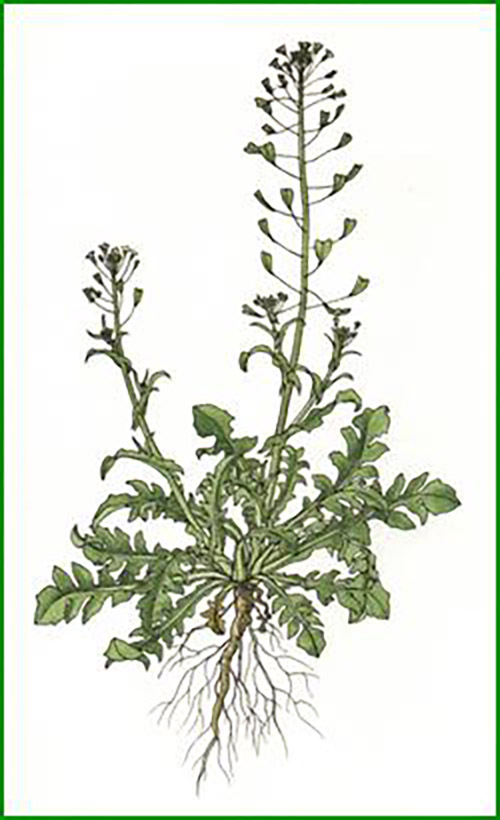
Shepherd’s purse was gathered prior to flowering and with seed already set and fermented with horse manure into a tea. The tea was liberally spread on a planting bed of young cabbage seedlings. The cabbage being a biennial in New Jersey normally developed a head in the fall planting and then flowered in the spring. The young cabbages that were set out in late summer for development skipped any hint at producing leaves but instead shot right up into flowering even in a well-manured and balanced planting bed. In their gesture, they didn’t resemble cabbages at all but looked just like shepherd’s purse. Of course, there was no cabbage harvest that year but a strong lesson was learned in plant morphology.
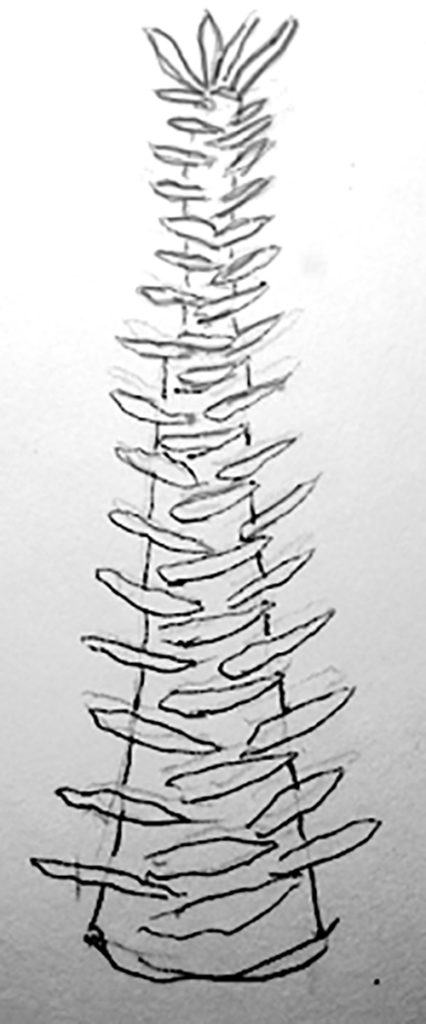
A few years later in California, the next valuable error involved the construction of a miniature plant form in the garden composed of flakes of serpentine rock and concrete. The form of the miniature tower was intended to create an image of a flowering process. The tower had flakes of serpentine as leaves, a calyx of serpentine flakes and a pistil formation of a chunk of serpentine. The finished sculpture was about four feet tall and a foot wide and looked like a giant flower at the end of a flower bed.
As the season progressed chard that was planted in a bed near the sculpture began to rapidly go into seed. Then the lettuce crop which was growing well, suddenly stopped growing and shot up to flower. After these two plants began to stop vegetating in favor of flower production the light went on for me and I saw that all of the cultivated plants in the vicinity of the serpentine sculpture had taken on a tall spindly gesture producing active inflorescences at the expense of any vegetative growth.
Reflecting on the shepherd’s purse error I decided to knock down the sculpture even though that seemed counterintuitive that a sculpture of serpentine would be able to influence plants at a distance. However, as I knocked down the sculpture I had a distinct impression that the garden in the vicinity of the sculpture was sighing and breathing out. The more intimate influences of minerals on plants were still a closed book to me at that time, but I was being led through errors into a realm of insight about morphological transformation.
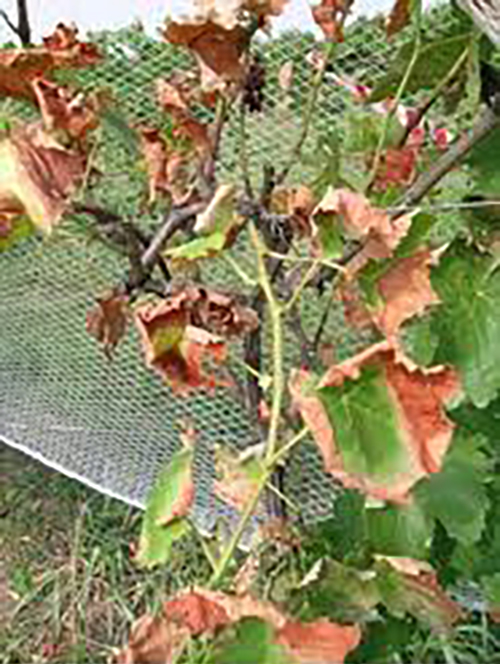
A third error was not my own, but was a final prompt to look more deeply into the gem/plant relationships regarding the transformation of formal gestures from minerals to plants.
This error occurred at a winery in California where the Biodynamic silica preparation was sprayed on wine grapes to counteract mildew pressure and to accelerate ripening in a wet and cold season. The grapes were sprayed just prior to ripening during a wet and cold period. The thought was that the silica would ward off fungus and kick an early ripening process into unfolding.
The method for the spray application was that if a little bit was good then a lot would be better. A series of silica sprays was undertaken and the plants began to respond by moving quickly into ripening. Then suddenly the weather took a turn from cold and wet to hot, windy, and dry. At first, the sprayed plants did well, but as the weather continued hot and dry the wind began to burn the foliage of the sprayed plants turning the leaf tips brown. Then it was the grapes themselves that showed distinct scars where the spray had been applied and subsequently was impacted by the sun.
In essence, the silica spray acted as a kind of blowtorch and nothing could be done except watch the plants that were sprayed on a south slope gradually turn brown, looking for all the world like they were literally burned by a fire. This was too much of a good thing. However, on reflection, the sprays were really silica gems stirred into water. What was the action of such a strong response in the plants? The mysteries of plant and mineral relationships were deepening.
Mineral Effects on Plant Formation
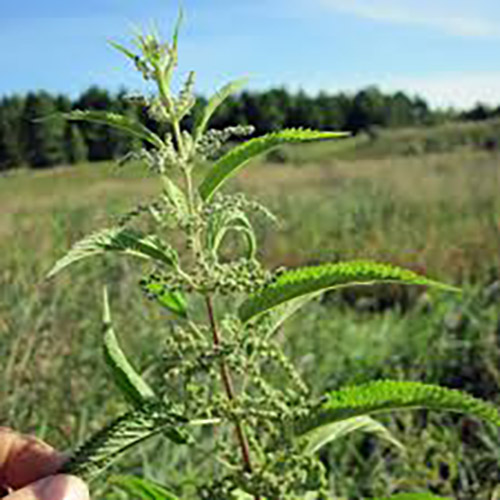
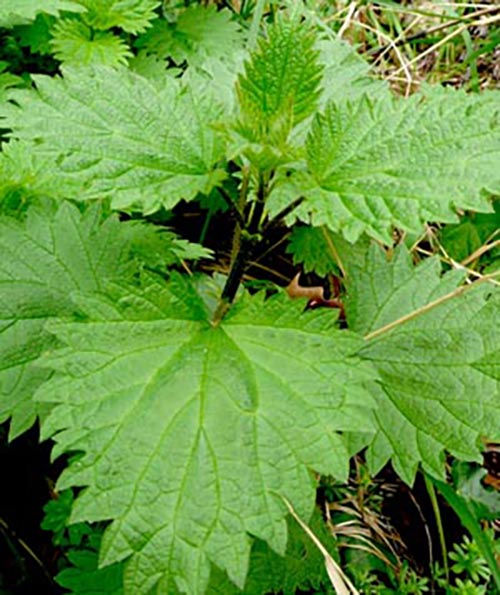
A simple experiment can show how the mineral realm influences plant formation by taking seedlings of nettle germinating them in a seedling flat and then transplanting them out to different soil types. A nettle plant is quite plastic in its ability to change form given different growing conditions.
In sandy soil, the nettle grows tall and thin with thin, dry leaves and is covered with silica-rich spines. The venom in the silica nettle is potent but does not easily lead to a quick rotting of the plant for fertilizer. There is a lot of residue. Flowering is reserved for the very top of the mature plant with little growth of side shoots. This is the case even when the sandy soil is kept moist such as found in nettles growing by a water source. It is the silica in the sandy soil that is revealed in this thin, light-influenced growth gesture. This gesture is like a bamboo or industrial hemp plant.
By contrast seedlings from the same sowing transplanted to a loamy and humus-rich soil will tend to grow squat and broad with thick leaves, thick stems that produce multiple shoots from leaf axils. The gesture is more like a shrub. The venom is potent and these plants will quickly rot completely into a strong fertilizer tea with little residue. The two soil minerals of silica as light and humus/clay as the dark gesture in the mineral realm point to a way to understand how a plant from one sowing can adapt to a polar mineral content of the soil to produce a polar light or dark gesture in the growth pattern.
From another angle, certain conditions of radically alternating soil types can produce remarkably different plant communities in very close spaces. These kinds of polarities can be observed in what is known as serpentine flora in the foothills of California.
In California there is a particularly unusual set of geological sequences that helped provide insight. This phenomenon is known as serpentine flora. It occurs in areas where volcanic intrusions have created dykes of ultramafic rocks that have intruded into settled felsic or granitic rocks. Mafic rocks have an abundance of magnesium (ma) and iron (fe) in their composition. They are basic in pH and are dark-colored and heavy and dense. The two primary constituents iron and magnesium are influential in the photosynthesis of the leaves of plants.
By contrast the granitic bedrocks are felsic in nature. They contain feldspars (fel) and silica (sic) in their composition.
In California geology, the Sierra mountains are felsic composed of a granite known as quartz monzonite. This granite is very acidic. Along the foothills going into the high country, subduction of oceanic plates made of an iron-rich basalt has created mafic melts that rise under the acidic felsic granites. Where these melts have reached the surface they form dykes of intruded ultramafic rock interspersed with bands of felsic quartz monzonite.
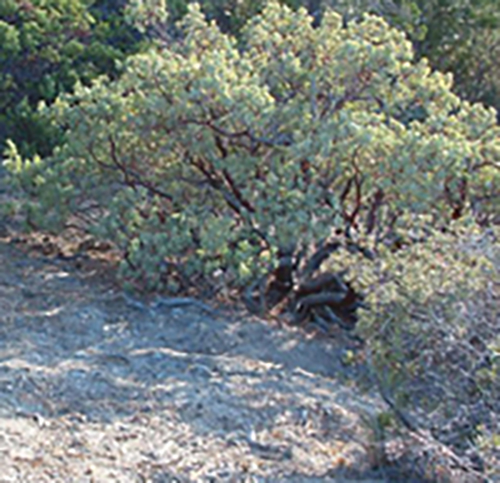
Walking through the mountains it is possible to pass through alternating bands of ultramafic and felsic rocks. Each rock form creates a soil that in turn creates conditions for radically different communities of plants. The polarities in the plant growth are between the serpentine flora communities that have adapted to what are toxic conditions for most plants to the ultra basic weathering of volcanic rocks. These communities occur in what are known as serpentine barrens. Polar to these plant communities are the plants of the high chaparral that are growing on acidic granite soils that weather out from the country rock that wasn’t intruded. The image shows a Manzanita bush growing in acidic granitic soil.
In the foothills because of the particular geology ultrabasic serpentine dykes a mere ten feet wide can alternate with accumulations of acidic decomposed granite of the same dimensions. It is possible to go for a walk and move in and out of serial populations of plants that have radical differences in form but are growing only a short distance from each other on the slope.
Plants being highly adaptive organisms can sometimes make a shift from one soil type to another with only slight changes in their outer forms. However, studies done on Artemisia species like sagebrush show that sagebrush grown on a serpentine lens produces four times less essential oil than sagebrush grown on a granite soil. The response in this case is not just in the form but in the chemistry. These polarities are the same gestures as the nettle plants grown in humus and in silica, but here the mineral polarities result in strong differences in medicinal properties. These exemplify how minerals can be used to amplify particular plant properties.
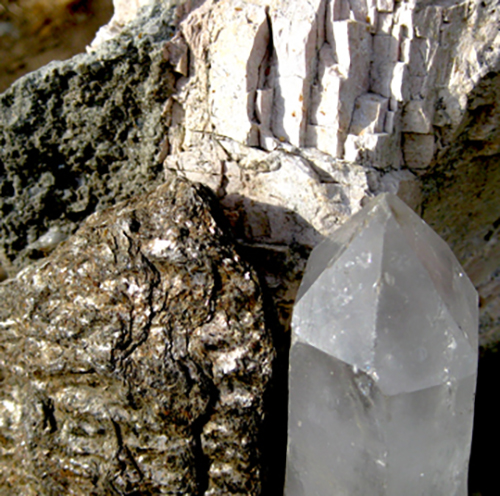
Given the transformation of minerals in the geological strata that give rise to the polarities in plant growth, it is useful to look at the fundamental divisions in the country rock itself. Country rock is the rock from which a soil is produced by weathering. Country rock is formed from magma. When the magma is allowed to cool slowly strong crystallization forces transform the melt into separate constituents depending upon the temperature at which the minerals form into crystals. The deposition and crystallization of the various constituents of the magma determine the ultimate form of the country rock that is acted upon by the weather.
The first to fall out of the melt are crystals that are only liquid at high temperatures. These are the dark iron/magnesium minerals like olivine, and pyroxenes. Among these early crystallizing minerals is the feldspar plagioclase which is rich in calcium. These are the mafic portions of the crystalline rocks. They crystallize early and sink through the other more liquid portions of the melt to settle at the bottom of the molten mass. The serpentine gesture comes from these minerals. As the iron and magnesium and calcium in the liquid melt becomes unavailable due to the crystal formation the liquid becomes richer in potassium and sodium, alumina, and silica.
In the transitional stages, the crystalline structure is highly changeable due to the crystal formation being so sensitive to very close differences in temperatures. The presence of more available alumina in the melt gives to the feldspars a formative template for what are known as phyllosilicates or platy silica minerals. These plate-like forms are characteristic of the mineral mica that serves as the fundamental template for clay formation. Clays are the intermediate forms between the high-temperature crystallizations of the serpentine or mafic minerals and the lower-temperature formations of the felsic minerals that produce many of the gem formations as the silica-rich solution finally starts to crystallize while the temperature of the melt is cooling. Once the melt has solidified and crystallized the structure of the originally molten mass is the mafic dark minerals at the bottom, the granitic granular minerals in the middle and the finer silicates and gem formations at the top. This arrangement forms a pluton of solid minerals deep within the earth. However, the solid nature of the pluton is not the end of the potentials for transformation from rocks to gems.
In many studies of medicinal plants it is possible to find that the texture of the soil is a key element in the abundance of medicinal properties. Stony, sandy, gravel-rich soils have a tendency to enhance essential oil content in Mediterranean-type cultivars. Humus-rich soils or peat soils have a tendency to provide too much of a shadow force that results in lowered essential oil production. Also trace metals in the soil can often be of benefit to particular species. Helichrysum italicum is a remarkable healing herb that produces the best healing oils in stony or gritty soils with humus content but not much in the way of fertilization. It is a seaside plant in Corsica, the site of the best oils. The country rock in Corsica originates from a backbone of mountains composed of quartz monzonite interspersed with bluestone schist. The blue-stone schist is a remnant of an ancient uplift that formed the mountains. The country rocks at that time were monzonite granites that were pressurized by a shift in oceanic plates that drove a hydrothermal solid solution through the granite that was rich in sodium and potassium. The addition of a granular high potash feldspar like Custer feldspar and a high sodium feldspar known to potters as minispar can duplicate the structural and metallic elements of the Corsican coastal soils. This mix of feldspars added to soil results in a very fragrant helichrysum inflorescence when worked into the planting hole with coarse sand even when the plant is growing in the clay loam of central valley of California. This type of metal/mineral research can be taken even further through the addition of gem composts and foliar sprays that make use of gems that are finely ground.
Once a mineral mass in the form of magma cools and crystallizes it can be further transformed by the migration of very hot hydrothermal solutions that percolate through the solid mass. In the cooling magma while the pluton is forming, the settling out of crystals is guided by metallic natures in the melt that in an ion exchange replace atoms in the original composition of the molten rock. In the settled pluton this metallic ionic exchange can continue hydrothermally.
In chemistry a metal is most often, but not always, a reactive species that can combine more or less readily with oxygen. The combination with oxygen often results in the transformation of the metal into a mineral or oxide of the metal. In this process there is a migration of atoms through the melt that replace other atoms found in the other metallic structures. This results in the migration of atoms from more reactive metals such as potassium to less reactive atoms such as calcium or magnesium and on to much less reactive metals like tin, copper and ultimately into the almost completely non-reactive gold. This reactive chain of metals is known to science as the electrochemical series. In this process metallic substances can be dissolved in hot water that percolates through even solid rock to change the formations of the crystals in the solid rock in profound ways. This process, known as solid solution transformation leads to the creation of gems in rock masses containing no gem formations.
Gem sprays and the action of smallest entities
The sequence of ideas that follow are an attempt at providing a rationale for the potential effects of gem sprays on plants. Current research into what Rudolf Steiner called the action of smallest entities occurs in many diverse scientific fields. This article aims to bring some of these ideas together into one protocol. There is no smoking gun for these sprays since the effects are very hard to measure with devices. However, repeated trials have shown the effectiveness of finely ground gems as sprays for enhanced plant growth. The following ideas are intended as an attempt to put a scientific underpinning to this research.
Surface Effects
In nature, the surfaces of objects are areas of intense activity. In a cell the surface is the site of exchange with the environment. Energy economy in nature dictates a move from large surfaces to the most minimal surface area possible so that organisms can reduce loss of energies to the environment. This is known as the law of minimal surfaces. The reduction of surfaces is an example of the critical relationship between volume and surface in natural forms.
Substances in cells move from areas of higher concentration to areas of lower concentration. A surface or membrane separates these two different areas of concentration and acts as a regulator of peripheral and centric movements of substances in and out of the cell. This imposes constraints on the size that a cell can attain before its mass or volume can no longer interact effectively with its environment. If a cell was an ideal spherical shape there would be an ideal ratio between its volume and its surface. As the cell got larger its volume would increase by cubes as a result of growth in three dimensions (height, width, and depth). At the same time its surface would enlarge by only two dimensions (height and width). This would mean at a certain size the cell would rupture because its volume would outpace the ability of its surface to contain it. The cell could also not interact with the environment because its volume in the center would be too far away from the surface. The surface area gets smaller relative to the volume as the cell gets larger. At a critical point, the cell must divide to bring its volume back into a harmony with the ability of the surface to act as a mediator with the environment.
Counter-intuitively as a cell or particle gets smaller the volume decreases at a faster rate( three dimensions) than the surface (two dimensions). This means as a particle gets smaller it has more surface available for interaction with its environment because it has much less volume. As a result, the surface of a very small particle is highly active in the colloids that govern the transformation of substances in living bodies. This is the realm of nanotechnology and nanoparticles are a prime example of the action of smallest entities. Nanoparticles have a much greater surface area to volume ratio than larger particles, so very small particles in sprays have great transformative potentials.
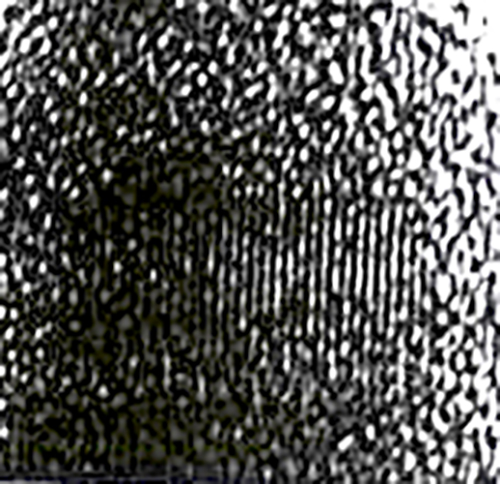
In technology, today minerals are said to be doped with metals in order to enhance their conductive capacities. Minerals can be thought of as fixed scaffolds of molecules such as silica. They resist currents. In the doping process, a fine solution of a metal such as boron is introduced into a melted solution of pure silica. The metal begins what is known as ion transfer by substituting for the mineral molecules in a specific ratio to create a lattice of metal/mineral substance. The image is a microphotograph of the interaction of a particle of boron with the silica solution. The more random boron is regularized into the silica matrix. When the boron completes its relationship, the difference between the silica that resists a flow of electricity (mineral) and the metal that conducts a flow of electricity sets up a potential for an oscillation. A current put into the finished doped crystal will oscillate between flowing and not flowing. This oscillation amplifies the current slightly. This is known as semi-conduction. If the crystal is cut into many small chips and current is applied to them each chip will semi-conduct and create a field of charges that amplify an initial current. The amplified current can be used to drive gates to open and close. This is the principle behind computer chips. Doping silica makes use of a principle that occurs in nature.

In a settled rock mass deep in the earth there are pores between the crystals that can be infiltrated with hot water under pressure. The water is carrying solutions of highly attenuated metals that flow through the hydrothermal pores in large masses of rocks. This results in a natural kind of doping within the rock mass. Mineral molecules in the settled or country rock are permeated with metallic ions. When this kind of ion transfer happens in nature the result isn’t a computer chip but a gem such as tourmaline or rose quartz.
Gems are naturally occurring doped semiconductors composed of minerals and metals in parts per million in precise molecular relationships. The images show that tourmaline is involved in a substitution process that occurs in two directions. Pressure from a large tectonic plate pushes boron-rich superheated water through the pores and around a crystal. This water is known as “rock milk” to geologists. The boron rock milk pulls chemicals out of the country rock crystal and deposits them in the downstream side of the flow in the lee of the crystal. Then the pressure on the plate releases and the flow of the boron rock milk rebounds and streams around the crystal in the opposite direction. Then the pressure resumes and the flow once again adds to the original crystal forms on the lee side. Over time the push/pull of these flows gives tourmaline its unique parallel inner structure that resembles the inner layers of plant organs. The rhythmic substitution of ions in tourmaline gives rise to a unique form principle in the gem.
In silica doping for chips, the rate of deposition and the rate of substitution are strictly controlled. The result is a homogenous mass with no form differences throughout the whole crystal. In nature, the doping is subject to various external rhythmic fluctuations in pressure and temperature that create formal motifs in the finished gems. These fluctuations can be used as indicators for which gems would be good for which plant sprays. The form of the gem and its chemistry contribute to the effectiveness of the finished spray. Doped silica in gems is an example of the action of the smallest entities.
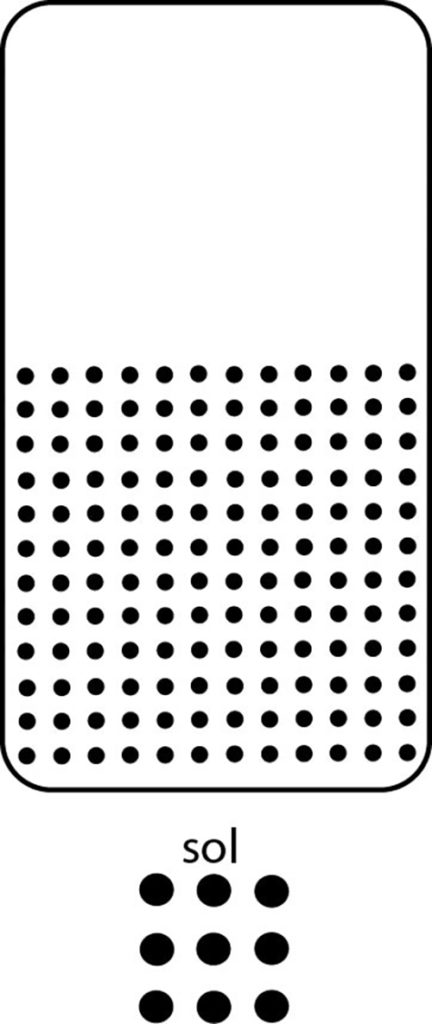
A third example of smallest entities can be found in the realm of colloidal fields. There are several examples of colloidal fields. Water vapor in air is a colloid of liquid in a gas. The little spheres of water are evenly dispersed in the air to form a colloid. Milk is a colloid of fat globules in water, a liquid in a liquid. Solids in liquids such as watercolor paints are another type of colloid. Egg white is a gel, composed of protein solids that are in a liquid. Colloids in nature have far reaching effects since most cell membranes are made of colloids as are most membranes in general. It is the membranes that react chemically to the transmission tensions between what is in a cell and what is in the environment of the cell. To make a gem spray that can be taken up by a plant it is necessary to get the particle size of the gem small enough that it forms another type of colloid called a sol. A sol is composed of solid particles in a liquid. However, if the solid particles precipitate out of the liquid then it is not a sol it is a suspension. To form a sol the particles of the gem need to be ground to such a small and regular size that the liquid acts like a field of forces in which each particle being very small has a much more active surface area. The large surface area creates a tension in the particle that results in one side having an electropositive charge and one side having an electronegative charge.
In nature, positive charges attract negative charges and vice versa. If the particles of the gem are finely ground and of a very small size, each particle with its one side of positive charge and one side of negative charge is free to orient in the fluid. That means that the fluid supports a field of highly organized positive and negatively charged particles. These very fine charges prevent the particles from settling out of the fluid. The suspension has now become a gem sol composed of mineral/metal parts per million doped gem particles ground into extremely fine size and acting like a colloid.
In nature, the field-like properties of colloids make them an ideal energetic vehicle for transport and transformation of substances that are dissolved or semi-dissolved in plants and animals. To be effective in these situations the colloid has to have a neutral charge. That way it can interact with membranes that are also colloidal fields and the interior of cells that are also colloidal. Chemistry within, without, and in the membranes of cells is regulated by the neutral charge of the colloids in the system.
In plants, the various charges that are carried by the metals and nonmetals in the sols and colloids both in the plant and in the soil are the basis for nutrition and growth. Membrane selectivity is heightened when both sides of a membrane are approached by substances arranged in colloidal fields. Metals such as potassium, calcium, magnesium and sodium tend to be the agents of radical reactive states seeking to gather charges from their electrolytic environment. Nonmetals such as phosphorus, carbon, nitrogen, and sulfur are the sources of the charges that the metals are seeking. Together the fields of attraction and interaction of metals and nonmetals are images of the forces at play in the growth of plants. When the metals and nonmetals are part of colloidal fields the interaction is at a maximum. If the gem particles are formed into a fine colloidal state a gem spray deposits a fine film of minute particles of mineral/metal-doped silicates(gems) on the surface of a leaf. It is these fine semi-conducting gem particles resting on the leaf that is considered to be the active principle of gem sprays.
Chelation in Nature
Metals in solution form complexes with other substances due to their tendency to seek out charges. This is the source of their reactivity. Some metals are more reactive than others, but most form complexes where their fundamental molecular shape is brought into a ring form. The ring form for molecules is very common in organic compounds such as proteins and complex sugars. The ring formation is also found in clays.
To form a chelate an electrolyte is necessary. Electrolytes are found in acids or enzymes or plant pigments found in chlorophyll. Chelation is also achieved by various forms of organic colloidal substances. A chelated metal is more readily taken up by plants from the soil since it is a very basic kind of chelation that guides ion transfer in hydrothermal ion transformation in rock faces. Chelates allow metals in diverse situations to circulate freely when substances like phosphorus and calcium become fixed.
In plants, the chelation of a metal with an acid or protein is much more stable in the context of complex chemical environments. Chelation is a kind of cooking or digesting of metals to make them more active in organic systems. It involves linking the metals to more organic substances so that the organisms that receive the metals in that form can assimilate them more efficiently.
Using herb vinegar as a chelating substance, small batch composts that create clay/humus colloidal complexes can be made to digest gem slurry for the purpose of making gem plant sprays.
Making Gem Slurry
The principle concept in making gem composts for plant sprays is that extremely fine gem powders contain metals in extremely fine dilutions that are analogs of the metallic dilutions of metals present in plant saps and soil solutions.
Gems such as rose quartz are first pulverized to a coarse powder form by percussion. Then in a rotary rock tumbler, the coarse gem powder is ground with pebbles of the same gem or with quartz crystals in order to render the particle size much finer than can be achieved by hand grinding on glass slabs. The rotary tumbler rotates many times a day and if the powders are combined in water with large pebbles, middle-sized pebbles and small pebbles, the action of the tumbling is similar to the action of stream water in nature. The different sizes maximize the interaction of the powder with other surfaces.
Three days of tumbling in a rotary tumbler makes a slurry that is fine but will easily settle out if left standing. The settling means that the particle sizes are too dissimilar and too large to form a sol. To render the particle size smaller and more uniform, a second type of gem tumbler is used. This is a vibratory tumbler with a hard rubber chamber that vibrates many times a second. The gem slurry is placed in this chamber with specially chosen rose quartz flakes that are flat. These are produced by careful breaking off flakes from larger chunks by using a cold chisel.
The flakes are first used as coarse grind pebbles in a rotary tumbler. They come out flat but with a rough surface. The rougher flakes are chosen to create a large, middle and small selection and put into the vibratory tumbler along with the slurry. Three days of vibratory polishing renders the coarse slurry into an extremely fine state while also polishing the flakes into a smooth surface. These flakes are then saved and used for polishing slurry of many different types of gems. The vibratory tumbler moves the flakes across each other without percussion. The action is like rubbing your hands together. Any particles of slurry that are caught between vibrating pebbles are ground horizontally by the flat flakes. This renders the coarser portions of the slurry into very small particle sizes. Also since the gems being polished are already in a powder form the vibratory tumbler with flat flakes of rose quartz tends to create uniform particle sizes in the finished slurry.
The addition of a bit of xanthan gum to the finished slurry creates a gel that supports the sol condition of the finished polished gem slurry. With this addition, the polished slurry takes on the condition of a colloid.
This colloidal gem slurry is then added to a compost mixture for the purpose of creating a chelating digestive cycle where the metals in the gem are combined with acids and clay/humus colloids in a fermenting cycle.
The final compost is crumbly and fine. It can be added to water, shaken, and allowed to stand overnight to steep. The liquid is then used as a base for foliar feeding. The gems make the plants sensitive to light so it is best to spray in the evening or at least in the late afternoon if there is mildew pressure. That way the leaves tend to resist burning.
Gem Types
Different gems can be used to create different components in a slurry. The following gems contain metals that have various functions in plant metabolism and can be used to support particular formative motifs when applied as sprays.
The idea here is that the gems when reduced to colloidal levels transfer to the plants aspects of form that the plants themselves use to deal with the ecologies in which they occur. The formative process that produces the gem form is used as an analog for finding a similar formative process in a medicinal plant. The goal through morphological resonance is to look for analogs that match the morphological ontogeny of the gem with the morphological ontogeny of the production of medicinal substances in the plant. These synergies are analogs of processes in animal tissues.
- Amethyst
- silica and iron and titanium
- analog of ingrowing pattern in heading plants like lettuce and cabbage
- Rose quartz, silica, iron and boron
- sustains metal migration to the meristem
- analog of meristem cell proliferation
- Pyrope garnet
- silica, iron and magnesium
- provides a magnesium center in the light antenna for photosynthesis
- Malachite
- copper and carbo
- copper aids in plant metabolism, light up-take, and enzyme production
- Turquoise
- copper and phosphorus
- provides phosphorus for metabolism and light uptake- analog of oil processes
- Orthoclase feldspar
- potassium-rich silicate for structural integrity
- analog of structural organs
- Plagioclase feldspar
- calcium-rich silicate for cell integrity and resistance to disease
- analog of structural organs
- Tourmaline
- a treasure house of many metals and micronutrients for overall balance
- analog of flower formation
- Opal (potch)
- silicate with unique relationship to light absorption and plant chemistry
- analog of cytoplasm production
- Mica
- silicate rich in soluble metals
- analog of plate-like leaf formations
- Sul-po-mag
- langbeinite
- balancing mineral brings sulfur to plants for enhanced metabolism and oil production
Light Metabolism in Plants
In the alchemical literature, there is a concept known as aeriform metals. This refers to metals that are not present in substantial ways but are the energetic templates for the eventual production of substantially manifest metals. This concept may be seen as a fantasy, but science recognizes that the sunlight that comes from our sun and other stars is composed of many colors of the spectrum.
It was long ago discovered that each of the lines of color in a very complex spectrum actually has a counterpart to a manifest and substantial metal. When sodium or potassium are burned the light that comes from the burning can be spectrographically analyzed. The light from the burning metal has quite specific wavelengths of color depending upon the substance.

The lines of this spectrum are the Fraunhofer lines named in honor of their discoverer. In essence, the starlight coming from deep space to continually bathe the earth in the form of energetic rays and particles contains aeriform metals. These energies are absorbed by plants through what science calls a light antenna. The light antenna is a series of purple, red, orange, yellow and green pigments within the chlorophyll structures of a leaf. These pigments absorb the aeriform metals in the light and transform the energies in the light to create substances based on sugars, salts and oils that form the body of the plant. These metals found in the salts and oils of medicinal plants are the sources of the healing and nutritional products these plants produce.
The goal of the gem spray is to deliver the metals and minerals in a fine colloidal form so that the leaves of the plant receive the light energies in a more precise way. We could say the goal is to enhance the metabolism of light in plants so that they achieve the maximum form potential for their species.
Nanoparticles and Coronal Discharge
A corona discharge is an electrical discharge brought on by the ionization of a fluid such as air surrounding a conductor that is electrically charged.
Wikipedia
Corona discharge is a process by which a current flows from an electrode with a high potential into a neutral fluid, usually air. A corona forms by ionizing that air around the tip of the electrode. The ions generated this way eventually pass charge to nearby areas of lower potential, or recombine to form neutral gas molecules. If a charged object has a point, the electric field strength around that point will be much higher than elsewhere. Air near the point can become ionized.
Nanoscale coronal discharges serve as thermally stable chemical reactors. In the regions where the discharges interact with gas, gaseous electrolytes are produced. The surrounding surfaces then undergo electrochemical reactions that produce enzymes. In plants these gas molecules are electrolytic, leading to enzyme production. Enzymes capture photons of light to further energize electrons in cascades of chemical potentials.
When in a region of induced electric activity, a neutral atom or molecule that is contained in a very small electrode can be ionized by a natural environmental energetic event (for example, being struck by an ultraviolet photon or cosmic ray particle).
The smaller the radius of the electrode the less voltage is needed to excite the atom. The excited atoms in the very small electrode or particle then cascade to create a corona. Extremely small particles can be excited to create coronal discharge by a millijoule current. A millijoule is one-thousandth of a volt produced in a current for the period of one second. This is a small amount of power.
The interaction of the small particle with the photon results in the formation of a positive ion and a free electron. The electron then goes on to interact with other electrode particles in a cascade. This happens many times when there are enough very small particles in an area. The result is an electron avalanche or cascade that creates a field of ionized air. When this field occurs on a plant leaf that situation creates strong potentials for chemical and energetic transformation of metals and minerals in plant saps. The particles must be ultra-small and capable of being excited by very small electrical charges.
An ultra-small doped silicate particle is capable of nanoscale coronal discharges with very low millijoule voltages such as from a photon from sunlight.
So for instance in the realm of plant growth, coronal discharge around the point of an excited doped silicate in an extremely small particle generates a localized coronal discharge that starts a cascade that creates an atmosphere rich in nitric oxide. Nitric oxide promotes the ability to overcome chlorosis and inhibits internode elongation. These are both processes mediated by light. Chlorosis or iron deficiency impairs chlorophyll biosynthesis and chloroplast development. Nitric oxide being bioactive can react with transition metals to form metal-nitrogen complexes. These complexes aid delivery of enzymatically active iron within the plant. This is a key to enhanced plant metabolism. The metal/nitrogen complexes are related to the activity of carotenoids in chlorophyll that induce sunlight into the leaves. A field of coronal discharges can induce reactions in the plant leaf that act as gaseous electrolytes, inducing cascades of electrochemical reactions. Chemical response to light in a flowering plant is a prime stimulus to the production of medicinal substances. To enhance that response is the goal of the gem sprays.
To summarize previous points:
Morphic resonance – In the mineral realm the reactivity of metals is the driving force for the morphology of crystallization whether from magma into rocks or through solid rocks by way of hydrothermal ionic transformation. The various processes by which the migration of metals induce changes in the rocks have characteristic sequences of changes that determine the eventual formation of the mineral. These processes give rise to formative principles in the evolution of magma into gem formations. To trace these changes gives an insight into the formative potentials for a gem with regard to the creation of a plant spray to guide the changes in the plant in particular ways. These form resonances are sought out as indicators of how to construct plant sprays that can enhance the production of medicinal substances within plant families.
Surface effects – in nature all transformative effects happen at the surfaces of objects. The smaller the size of the object the greater the surface area in relation to volume. Grinding gems to ultra-fine size increases their surface-to-volume ratio making the metals in them more active in chemical transformations.
Metals in fine dilution in minerals – The computer industry runs on the principle of doped silicates or semiconductors. Doping means to put very fine dilutions of metals into molten silica. The metals replace some of the atoms in the silica structure. The metals then provide for transmission of a current while the silicates resist transmission creating an oscillation that makes the silica a semiconductor. The silica is then sliced into chips. The oscillation of current in a chip enhances an input charge. The chip is then used to amplify input energies. A similar substitution phenomenon happens in nature when hydrothermal metallic solutions replace ions by flowing through settled rock masses. This process underlies gem formation.
Colloidal fields and sols – Metals such as potassium, calcium, magnesium and sodium create reactive states in plants by seeking charges from their environment. Nonmetals such as phosphorus, carbon, nitrogen, and sulfur provide the charges that the metals are seeking. The interaction of metals and nonmetals in extremely fine gem sols are very similar to the forces at work in plant sap. When metals and nonmetals are part of extremely fine colloidal fields known as sols this action is at a maximum. When gem particles are formed into a sol, the gem spray deposits a fine film of minute particles of mineral/metal-doped silicates (gems) on the surface of a leaf. It is these fine semi-conducting gem particles resting on the leaf that are considered to be the active principle of gem sprays.
Chelation – Metals in nature need to be engaged or grasped by acids or colloidal substances in order for living entities to make use of their transformative forces. Without this engagement, the metals are a bit antagonistic to living cells. The union of a metal and an acid or colloidal substance is called chelation. Using herb vinegar or even plant hydrosols as a chelating substance, small batch composts that create clay/humus colloidal complexes can be made to digest gem slurry for the purpose of chelating the metals found in powdered gems.
Making gem slurry – Grinding gems to make them fine enough to approach sol states is made possible by crushing gems into coarse powder then using a rotary rock tumbler to render the coarse powder into a finer state that creates a slurry. The slurry of the gems is then put into a vibratory rock tumbler to bring it to a fine polished state that features gem particles capable of staying in a sol state for an extended period of time. For a slurry to stay in the sol state means that some of the gems have been ground down to the size region where surface and volume reverse.
Light metabolism in plants – The science of Fraunhofer spectral analysis of light frequencies of incandescent metals can serve as a basis for supporting the older alchemical concept of aeriform metals. The aeriform metals can then be linked to the formation of light-sensitive pigments in plants that form what is known to plant science as the “light antenna”. The series of chlorophyll variations based on metallic salt transformation in the soil solution is the light antenna that allows plants to convert sunlight into sugars and oxygen. These metallic based pigments then serve as the building blocks for medicinal substance formation such as oils and water-soluble materials that bring healing forces to humans.
Nanoparticles and coronal discharge – The creation of plant enzymes that facilitate pigment formation is enhanced when the photon energies in sunlight are slightly amplified by what science recognizes as a coronal discharge from a nanoparticle. Extremely small doped silicate particles from gems when covering the surface of a leaf respond to the energies of sunlight by amplifying enzyme production through the production of gaseous electrolytes. This means that each small particle of a film of gems on a leaf is acting to enhance the potentials for the production of secondary metabolites. Plants use these substances to first attract pollinators and then when the seed is developing to protect the embryos. The attractants and repellents are in the form of phenolics and terpenoids that serve the plant that is moving into flowering and seed production. These substances are the final manifest and substantial state of the aeriform metals in the energies of the sunlight. They are the holy grail of medicinal plant studies.
A final anecdote may serve to illustrate the subtle aspect of this work. The gems that are processed are applied to the plants with sprays made from fermented plants that are rich in plant growth hormones such as cytokinin, auxin, and gibberellin. These hormones support the action of the minerals. Many research articles point to the presence of abundant cytokinin in the sap of grapes before the buds break in the spring. The action of cytokinin is to stimulate the opening of the buds in the dormant canes from last year. This year (2019) two gallons of sap were collected from Thompson Seedless grapes, a kind of table grape. The gem ferments for this year were given rich supplies of this sap instead of the laborious germinating and mashing of field corn that was the hormonal base of the cytokinin sprays last year. The sprays last year resulted in strong axial shoot growth in cultivated plants particularly basil.
This year the basil seedlings were sprayed with the new gem spray formula based on the Thompson Seedless sap. Initially, there was a good response from the sprayed plants but then the grapes broke their buds and long canes emerged from the buds. As the long canes emerged from the grapes, the basil plants likewise shot extremely long axial bud shoots with very long internodes.
Last year the internodes of the basil axial shoots were short with abundant axial shoots all along the stems. I watched in amazement as the basil plant shoots followed the grape canes in a gesture of extreme elongation. I knew that this was a signature of the plant hormone gibberellin. Cytokinin promotes cell division and gibberellin promotes the elongation of the cells that are dividing.
An internet search for gibberellin and Thompson Seedless grapes revealed that there was research done at the University of California, Davis on the abundant presence of gibberellin in the Thompson Seedless variety of table grapes. Gibberellin as a hormone was discovered in rice plants. The goal of the research at Davis was to find a source of abundant gibberellin for rice research.
To remedy my overly elongating sprays I resorted to cutting my ferments in half with a cytokinin-rich mixture of kelp and coconut water. That has diminished the extreme elongation of the sprayed crops but the overall gesture is still not the axially dominant growth pattern displayed last year in the cytokinin-rich sprays.
Next year the coconut water will most likely replace the Thompson Seedless sap in the ferments as well as a reliance on malted barley extract as the sources of abundant cytokinin in the ferments.
The Goethean morphological significance of the grape gesture being transferred to an herb plant is profound in its implications.
The idea in this paper was to present a case for gem sprays for enhancing medicinal substances in plants. Current research is pointing at the curious phenomenon that as plants accumulate more CO2 from the atmosphere their photosynthetic processes go into overdrive. This causes an increase in the formation of sugars at the expense of the formation of proteins. The accumulation of more carbohydrates in the cells of the plants has also shown in experiments to reduce the ability of the plants to mobilize calcium, potassium, iron and zinc. This has grave implications for human nutrition. In essence, the plants are substituting growth for formative principles.
The use of gem sprays in conjunction with hormonally rich ferments has shown to enhance the form principles in plants when applied in very fine mist applications in rhythmic sequences. The hope is that the use of gems as sprays will bring balance to plant life in this regard.
In this paper, the attempt to link contemporary scientific concepts to this research is not intended as proof but as a working principle that hopefully can lead to more potent naturally based plant remedies to meet contemporary health challenges.
For more on this, please see Gems and Plants for Healing Chronic Illness – Greenwood Gathering a video presentation of these concepts, or join us in Gem and Plant August-September 2023 to learn how to make your own plant sprays.

Dennis Klocek
Dennis Klocek, MFA, is co-founder of the Coros Institute, an internationally renowned lecturer, and teacher. He is the author of nine books, including the newly released Colors of the Soul; Esoteric Physiology and also Sacred Agriculture: The Alchemy of Biodynamics. He regularly shares his alchemical, spiritual, and scientific insights at soilsoulandspirit.com.
2 Comments
Leave a Comment
Similar Writings
Tree Painting as an Esoteric Deed
This article addresses the gardeners out there who have a little time to engage in a practice that might seem like at total waste of time to a busy agriculturalist. Ever since I read an article in an old Bio-Dynamic magazine on the blood and milk method I have been trying to work out a…
Rediscovering the Sacredness of Nature: Interview with Dennis Klocek
Dennis Klocek is an artist, scientist, teacher, researcher, gardener, and alchemist. He lives and works in Sacramento, California and is Director of the Consciousness Studies Program at the Rudolf Steiner College in California. He has been a great inspiration for many people over the years and has given workshops and talks on a variety of…
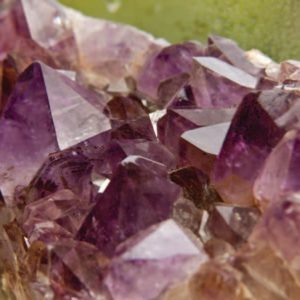
Is 501 D30 putting fine layers of silica over the leaves?
Why not just put the crystals in water and place them in the Sun for awhile?
Great question, Glen. Dennis will address these questions in the Gem and Plant course.